
Gracillaria syringella is a moth of the family Gracillariidae. It is found in Europe. It has been introduced in North America.

Prays fraxinella, also known as the ash bud moth, is a moth of the family Plutellidae found in Europe. The larvae are leaf miners, feeding on the leaves and buds of ash trees.

Eriocrania salopiella is a moth of the family Eriocraniidae and is found in Europe. It was described by the English entomologist, Henry Tibbats Stainton in 1854. The larvae mine the leaves of birch.

Eriocrania unimaculella is a moth of the family Eriocraniidae found in Europe. It was first described by the Swedish naturalist Johan Wilhelm Zetterstedt in 1839. The larvae feed inside the leaves of birch, making a mine.

Parornix anglicella is a moth of the family Gracillariidae found in Asia and Europe. It was described in 1850, by the English entomologist Henry Tibbats Stainton, from a specimen from Lewisham, Kent.
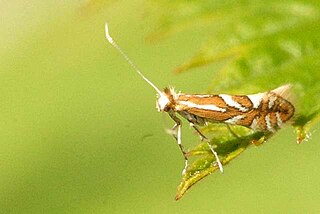
Phyllonorycter oxyacanthae is a moth of the family Gracillariidae found in all of Europe except the Balkan Peninsula. It was described by the German-born Swiss entomologist, Heinrich Frey in 1856. The larvae are known as leaf miners, living inside the leaves of their food plants.
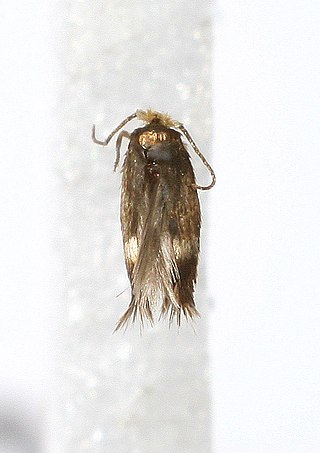
Stigmella microtheriella, the Hazel leaf miner moth, is a moth of the family Nepticulidae. It is found in Asia, Europe and New Zealand. The larvae mine the leaves of hazel and hornbeams. It was described by the English entomologist, Henry Tibbats Stainton in 1854 from a type specimen found in England.

Enteucha acetosae, the pygmy sorrel moth, is a moth of the family Nepticulidae found in Europe. It is one of the smallest moths in the world with some having a wingspan of only 3mm. The larvae mine the leaves of docks, leaving bright red tissue around the mines.

Phyllonorycter coryli, or nut leaf blister moth, is a moth of the family Gracillariidae. It is found most of Europe, except the Balkan Peninsula.

Phyllonorycter heegeriella is a moth of the family Gracillariidae. It is found in all of Europe, except the Iberian Peninsula and the Balkan Peninsula.
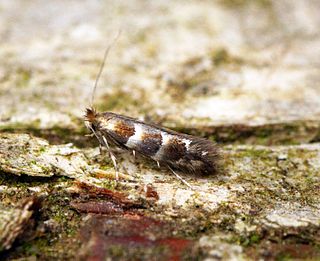
Phyllonorycter nicellii is a moth of the family Gracillariidae. It is found in most of Europe, except the Balkan Peninsula and the Mediterranean islands.
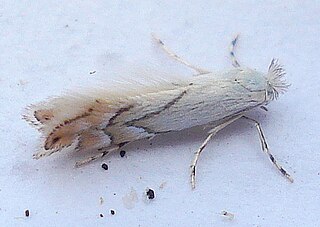
Phyllonorycter harrisella is a moth of the family Gracillariidae. It is found in all of Europe, except the Balkan Peninsula and the Mediterranean islands.
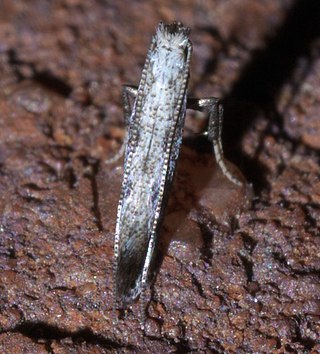
Parornix is a genus of moths in the family Gracillariidae. The genus was raised by the German entomologist Arnold Spuler in 1910.

Phyllonorycter emberizaepenella is a moth of the family Gracillariidae. It is found in all of Europe, except the Iberian Peninsula and the Balkan Peninsula.
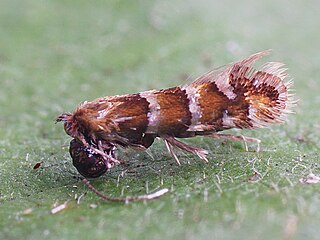
Phyllonorycter klemannella is a moth of the family Gracillariidae. It is known from all of Europe, except Greece.

Phyllonorycter nigrescentella is a moth of the family Gracillariidae. It is known from all of Europe except the Balkan Peninsula.

Parornix betulae is a moth of the family Gracillariidae. It is known from all of Europe, east to Korea. It was recently reported from Canada, with records from Québec, Ontario and British Columbia.

Parornix loganella is a moth of the family Gracillariidae. It is found from Fennoscandia and northern Russia to the British Isles, Denmark and the Baltic States.

Parornix scoticella is a moth of the family Gracillariidae. It is known from all of Europe.
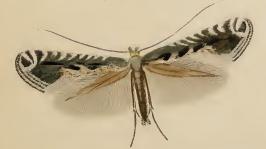
Parornix torquillella is a moth of the family Gracillariidae found in Europe. The larvae mine the leaves of Prunus species, such as blackthorn. It was described by the German entomologist Philipp Christoph Zeller in 1850, from specimens found in Florence, Leghorn and Pisa.


















